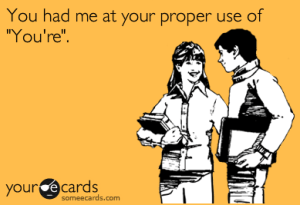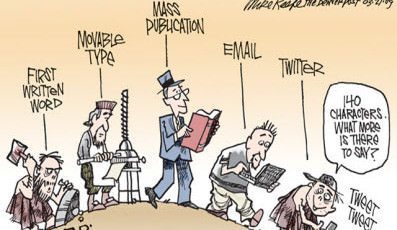Twitter is an important tool every brand should use to build and engage their customer base. Due to the 140 character limit and specific Twitter terminology, many users create their own style of Twitter messages. This can lead to Tweets that lack grammar, and are confusing to the reader. As the platform grows, the need for rules of good Twitter grammar and usage increases as well.
Twitter Grammar and Usage:13 Tips for Twitter Success
Tim Chilcote at Ignite Social Media has produced a great article on Twitter grammar and usage. His rules lay out a clear blueprint for brand marketers to follow when attempting to engage customers:
“Whether you’re a major brand or an individual tweeting from a professional account—even if you just use Twitter in your personal life—the better your style, the more clearly your message will be received. Here are 13 tips to clean up your message and engage your audience:
1. Compose Tweets with Care
My high school English teacher used to say, “If you’re counting the words you write, you’re not writing the words that count.” He never met Twitter. Now, not only do we count our words, we have to count our characters. Proofread your tweets, read them aloud when possible, and leave enough characters for an old-school “RT” retweet. Allow followers to amplify your message with minimal effort (see tip #3).
 2. Tweets Start with Words, not Periods
2. Tweets Start with Words, not Periods
Somewhere about halfway through Twitter’s young life, users wised up to the fact that not all their followers were seeing @ replies. As a workaround, people began adding periods to open a Tweet, so all their followers would see the message. Here’s the problem: more often than not, a period to open a tweet is a signal that the message is either going to be a snarky complaint or brag, neither of which is ideal. Instead of tacking a period to the beginning of your tweet, rearrange your message.
3. The Real Limit is Less than 140 Characters
The real limit is 140 minus “RT @YourName:” Give followers enough leftover characters (~20) for an old-school retweet. Heck, leave even more characters so people can add a comment. The more retweets, the more conversation, the more engagement. Again, make it easy for your followers to spread your message.
4. Avoid Shorthand
Social media is not a private instant messaging service. That means no LOL, RU, BRB, NP, etc. Shorthand or insider slang is acceptable in a one-on-one online conversation with a friend. But in a public forum, it can be off-putting. And if your tweet gets picked up and shared by a news organization, industry leader, or celebrity, you’d be better served to clearly spell out your meaning. I even prefer “HaHa” over “LOL” to “laugh” online. There’s nothing funny about ROFL.
5. The Difference Between RT, MT, and a Native Retweet
Call me old fashioned, but I prefer the old-school “RT” retweet.
Old-school retweets are still the most reliable method for notifying users since Twitter perceives them as @ tags. They are also good for adding comments. I only use the native retweet when character limits don’t leave enough space for an old-school retweet. The more recent adoption of “MT” (modified tweet) throws an additional wrench in the mix. I’m not a huge fan of the MT, which is now used to alert followers that the content of a retweet has been edited. Looking back to my teaching days, I’d suggest that the MT is only necessary if the meaning of the tweet has been fundamentally altered.
6. Shorten URLs
Shorten the links in your tweets using Bit.ly or Google Url Shortener. These shortening services will buy you characters (depending on the platform from which you’re tweeting) and help you track clicks. And even if you’re not tracking your links, at least you’ll look like you are. Think of each tweet as a mini job interview. Dress your tweets for the success they’re seeking.
7. Tag Relevant Twitter Handles
Whenever possible, tag people in your tweets, even if it’s a celebrity who is unlikely to engage. Tags help add context for your followers, tags show that you’ve composed your tweet with care, and tags are more likely to keep the conversation growing, right @JustinVerlander?
8. Avoid Connecting Third-Party Apps when Possible
Third-party apps don’t play well across platforms. Of the red flags on Twitter, nothing is more glaring than a shortened link coming from Facebook. You might as well add a prefix to your link: DON’T CLICK ME. EVER.
9. The @ Symbol is Silent
The @ symbol is for replying and tagging only; it does not serve the dual purpose of replacing the word “at.”
10. Set off Links with the Appropriate Punctuation
There’s no perfect solution. A colon is probably the most grammatically correct, a simple period is probably the most visually appealing, and occasionally an em dash adds context. However you choose to set off your links, be consistent.
11. Use Vertical Breaks and Brackets to Clarify and Include Notes for Readers
Clarity is essential for engagement with a tweet. When you’re linking to a YouTube clip, make it clear to your followers that they’ll see a video when they click the link. This increases clicks and builds trust for future tweets. The best way to notify followers of your intention is to note the content source with a vertical break or brackets.
12. Single Quotation Marks are Acceptable Replacements for Italics
Since it’s not possible to add text formatting to Twitter, single quotes are an acceptable substitution if you need to grammatically use italics to make your point.
13. Oh, the Hashtag
Research your hashtags to make sure they’re being used (unless you’re starting a tag or adding one for comedic effect), don’t overdo it, and use hashtags in-text when possible for smooth composition. If you need to add them to the end of a tweet, separate hashtags from your tweet with a vertical break to alert your followers that they can stop reading for meaning. And if you’re starting a new tag or adding one for comedic effect, be as original and memorable as possible without spending too many characters. #ThereWillBeATest”
Twitter Grammar and Usage in 140 Characters
Additionally, Grammar Girl’s Mignon Fogarty used 140 characters or less to provide her style guide to simple rules for Twitter grammar and usage:
- Don’t start posts with “I am.” You’re answering the question, “What are you doing?” It’s OK to answer with fragments in a conversation.
- Use proper capitalization. Typing in lowercase doesn’t save characters; it’s just lazy.
- Use proper basic punctuation. It helps people understand what you mean.
- Don’t use abbreviations such as 4U and L8. They make you sound like a 12-year-old (which is bad, unless you actually are a 12-year-old).
- Use contractions whenever possible.
- Shorthand symbols such as >, =, &, and @ are allowed.
- Shortened word forms such as nite and thru are allowed.
- Use numerals, not words, for all numbers.
- Provide links and context whenever possible. Remember that many of your followers can’t see what you are responding to.
- If you can’t say it in 140 characters, reevaluate whether you should be posting it at Twitter.
































1 Comment to Twitter Grammar and Usage: Style Tips